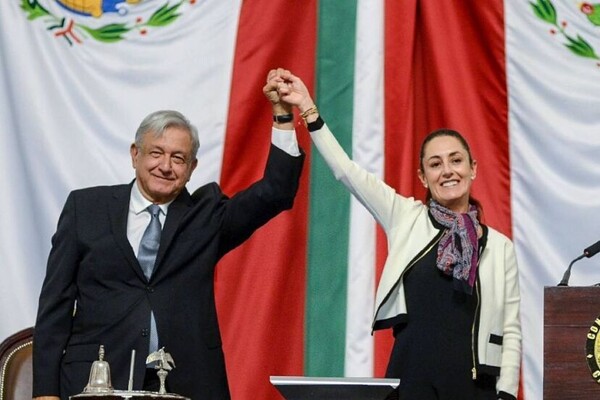
A study warns that “the working conditions for journalists remain among the most precarious and dangerous in the world.” According to the study, “the Mexican media landscape remains highly commercial and is strongly concentrated in a few main actors.” It also warns that “a new Transparency Law has led to investigative journalists fearing for their future access to public information, a resource that has been vital in recent years for uncovering corruption.” In the labor sphere, Mexican journalists “face generalized job insecurity and remain vulnerable to frequent attacks that put their moral integrity and reputation at risk.” According to the report, it “carried out its first regional transmission for Donald Trump's inauguration in January, using presenters from both Mexican television (Denise Maerker and Enrique Acevedo) and its U.S. station Latino TV (Ilia Calderón), with streaming and broadcast audiences of around 20 million.”
Journalist Carmen Aristegui remains one of the main opinion leaders in Mexico, according to the latest report 'Mapping News Creators and Influencers in Social and Video Networks,' prepared by the Reuters Institute and the University of Oxford. “Aristegui's investigative work on abuses of power has made her one of the country's most recognized watchdogs of power,” the document states, placing her second in the list of news leaders with the most mentions on social media and video in Mexico in the survey conducted by both institutions. “In addition to hosting a program on CNN in Español, she is also the face of Aristegui Noticias, an online news portal she founded in 2012. Her morning newscast Aristegui en Vivo is broadcast daily on her website and YouTube, as well as on the portal of La Octava (Grupo Radio Centro),” it says.
In first place for mentions is journalist Carlos Loret de Mola, a former Televisa host, who presents the radio program Así las cosas on W Radio and is a co-founder of the digital medium Latinus, which mentions its criticism of the government of former President Andrés Manuel López Obrador (AMLO). “At the top of the list, Carmen Aristegui and Carlos Loret de Mola are both veteran journalists with continuous presence in traditional media who have also launched successful digital news ventures,” the report states. In third place is journalist Joaquín López-Dóriga, who worked much of his career at the Televisa network and currently hosts a program on Radio Fórmula, in addition to having an internet portal and activity on social networks.
The report highlights that traditional news brands continue to be an influential force in Mexico's media ecosystem, which “ranks fifth in attention to traditional media and journalists on social media platforms.” However, the study shows that these coexist with a dynamic universe of digital creators, where journalists, YouTubers, and entertainment figures stand out. The study indicates that in a country where “nearly two-thirds of the population get news from social media each week and more than 40% say it is their main source of information,” “strong brands like N+ (Televisa) and TV Azteca coexist with a thriving ecosystem based on personalities.” The list of the most mentioned people “reflects a hybrid ecosystem of creators that combines several well-known hosts and investigative journalists—who have defined Mexican television for decades—with pro-government YouTubers with loyal audiences and comedians who blur the line between politics and entertainment.”
Mexico's digital landscape, according to the study, is marked by the role of politically aligned YouTubers, “a group of creators that gained relevance during AMLO's presidency, closely linked to his Fourth Transformation (4T) movement.” Among them stand out “the rapid-fire interventions of El Chapucero” and “the more conversational and accessible videos of El Charro Político,” who were “an important part of AMLO's digital ecosystem, defending policies, confronting critics, and shaping the tone of online debate during a government that maintained a combative relationship with traditional media.” With the arrival of Claudia Sheinbaum to the presidency, the report observes that “she has generally adopted a less hostile approach to the media than her predecessor, but continues to give pro-4T YouTubers access to press events such as the morning press conferences.” These morning press conferences, it notes, “are often criticized for attempting to evade scrutiny from traditional media.” The study recalls that these “influencers” “have not been exempt from controversy,” as “fact-checkers have documented cases where these channels spread misleading or false information, especially during the pandemic.”
The report also dedicates space to the influence of satire and entertainment on public debate. In parallel, “Infobae México, the local version of the Argentine digital medium, is increasing its influence,” and “UnoTVNoticias has been recognized for innovating by delivering news for free via SMS to millions of people.” In terms of innovation, the study observes that “the adoption of artificial intelligence in Mexican media faces multiple barriers, such as high implementation costs, lack of trust among editors and journalists, and limited technical training,” although it recognizes that “there is significant potential for both innovation and efficiency.” The report also highlights the rise of audio content, “although podcasts are not yet the primary medium for accessing news for most.” A month later, “the company announced a round of layoffs while continuing its digital transformation.”
The Editorial Mexicana Organization (OEM) “owns 70 regional newspapers (along with 24 radio stations and 44 websites),” while El Universal, “the country's oldest newspaper, remains the most important, in addition to having the most visited website.” Its model “is hybrid, combining print subscriptions with premium online content (El Universal Plus) and digital advertising.” The newspaper Reforma also “maintains a premium paywall alongside its print subscription.” Meanwhile, “other national newspapers, such as El Heraldo, Milenio, and Excelsior, are diversifying with digital editions and projects in television and radio.” The study underscores that La Jornada, “which supports the government, depends almost entirely on public advertising.” The report describes Claudia Sheinbaum as “the most-watched online news streamer in the country thanks to her popular daily press conferences, which can last up to two hours.” Although “she has adopted a more conciliatory approach with the media than her predecessor Andrés Manuel López Obrador,” she maintains “a section every Wednesday dedicated to pointing out journalists who share so-called 'fake news.'” It highlights that with a supermajority in Congress, her administration “has been able to pass reforms that, among other things, have eliminated some independent institutions, such as the National Institute of Access to Information (INAI), the Federal Institute of Telecommunications (IFT), and the Federal Economic Competition Commission (COFECE).” The report also indicates that Sheinbaum “has granted the government significant powers over the judiciary, which has generated complaints from the opposition about growing autocracy.”
El País México “has established a regional newsroom in the Mexican capital with some free content and other premium content behind a paywall.” It mentions that “Brozo, the clown character played by Víctor Trujillo, remains one of the country's most recognizable political commentators,” while the “infotainer Adela Micha” and content creator Luisito Comunica “show how non-political influencers also occupy a relevant space in the region's news creator scene.” The study emphasizes that “although still far from parity, women have a stronger presence in the landscape of news creators than in other Latin American countries analyzed.” It highlights that “three of the four women on the list actively speak about politics or are directly involved in it, including Sheinbaum, who is the first female president of Mexico.”
Media Concentration and the Risks to Journalism in Mexico
In parallel, the Reuters Institute Digital News Report 2025 was published, which describes a media landscape in Mexico marked by corporate concentration, precarious labor in journalism, and the growing influence of the digital environment. The report states that “Mexican President Claudia Sheinbaum came to power in June 2024 promising a change in the political climate, but her large majority has generated fears about the concentration of power.” It highlights the role of TelevisaUnivision, which “owns the most important broadcasting media and recently reorganized its news division under the N+ brand,” as part of “a multi-platform strategy to reach younger and more digitally savvy audiences that are increasingly consuming news online and on mobile devices.” The group has also driven “its streaming platform ViX, a hybrid service with some free channels and others by subscription,” and strengthened “24-hour news coverage within the platform.” According to the document, “the NGO Article 19 has also registered four murders since the new president took office, the most recent being that of Kristian Uriel Martínez Zavala, founder of the news site Silaoense MX, who was murdered in March in Guanajuato.” The report also highlights the growing presence of international actors.













